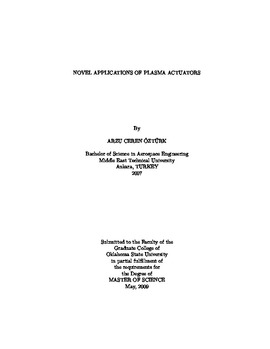| dc.contributor.advisor | Jacob, Jamey D. | |
| dc.contributor.author | Ozturk, Arzu Ceren | |
| dc.date.accessioned | 2014-04-17T19:53:29Z | |
| dc.date.available | 2014-04-17T19:53:29Z | |
| dc.date.issued | 2009-05-01 | |
| dc.identifier.uri | https://hdl.handle.net/11244/10016 | |
| dc.description.abstract | The current study investigates the effectiveness of two different dielectric barrier discharge plasma actuator configurations, a 3-D annular geometry for use in micro thrusters and internal duct aerodynamics and a jet vectoring actuator that acts as a vortex generator and flow control device. The first configuration consists of a closed circumferential arrangement which yields a body force when a voltage difference is applied across the inner and outer electrodes separated by a dielectric. The primary flow is driven by this zero-net mass flux jet at the wall that then entrains fluid in the core of the duct. PIV experiments in both quiescent flow and freestream are conducted on tubes of different diameters while varying parameters such as the modulation frequency, duty cycle and tunnel speed. The values of the induced velocities increase with the forcing frequency and duty cycle although there is a peak value for the forcing frequency after which the velocity and thrust decrease for each thruster. The velocities and thrust increase as the inner diameter of the tubes are increased while the velocity profiles show a great difference with the (l/di) ratio; recirculation occurs after going below a critical value. Experiments in the wind tunnel illustrate that the jet exit characteristics significantly change upon actuation in freestream flow but the effect tends to diminish with increasing inner diameters and tunnel speeds. Using staged arrays of these thrusters result in higher velocities while operating at both in phase and out of phase. The jet vectoring configuration consists of a single embedded electrode separated from two exposed electrodes on either side by the dielectric. The embedded electrode is grounded while the exposed electrodes are driven with a high frequency high voltage input signal. PIV measurements of the actuator in a freestream show that vectoring the jet yields stronger vortices than a linear configuration and increasing the difference between the duty cycles of the channels increases the vortex strength. It is seen that while the vortex is barely visible at the leading edge with little strength, it grows significantly large in the streamwise direction and reaches its maximum strength around mid-chord locations while the circulation distribution shows that the bulk of the circulation is added here. The motion of the vortex along this direction illustrates a braiding phenomena that can be observed via flow visualizations. Streamwise PIV data for this configuration on a wing with a NACA 0012 airfoil is used to plot the reverse flow probability, which in turn reveals that the use of the jet vectoring actuator as a vortex generator jet does suppress separation, but the actuator tends to lose its efficacy with increasing tunnel speeds. | |
| dc.format | application/pdf | |
| dc.language | en_US | |
| dc.publisher | Oklahoma State University | |
| dc.rights | Copyright is held by the author who has granted the Oklahoma State University Library the non-exclusive right to share this material in its institutional repository. Contact Digital Library Services at lib-dls@okstate.edu or 405-744-9161 for the permission policy on the use, reproduction or distribution of this material. | |
| dc.title | Novel Applications of Plasma Actuators | |
| dc.type | text | |
| dc.contributor.committeeMember | Arena, Andrew S. | |
| dc.contributor.committeeMember | Chambers, Frank W. | |
| osu.filename | OZTURK_okstate_0664M_10179.pdf | |
| osu.college | Engineering, Architecture, and Technology | |
| osu.accesstype | Open Access | |
| dc.description.department | Mechanical & Aerospace Engineering | |
| dc.type.genre | Thesis | |
| dc.subject.keywords | engineering | |
| dc.subject.keywords | aerospace | |
